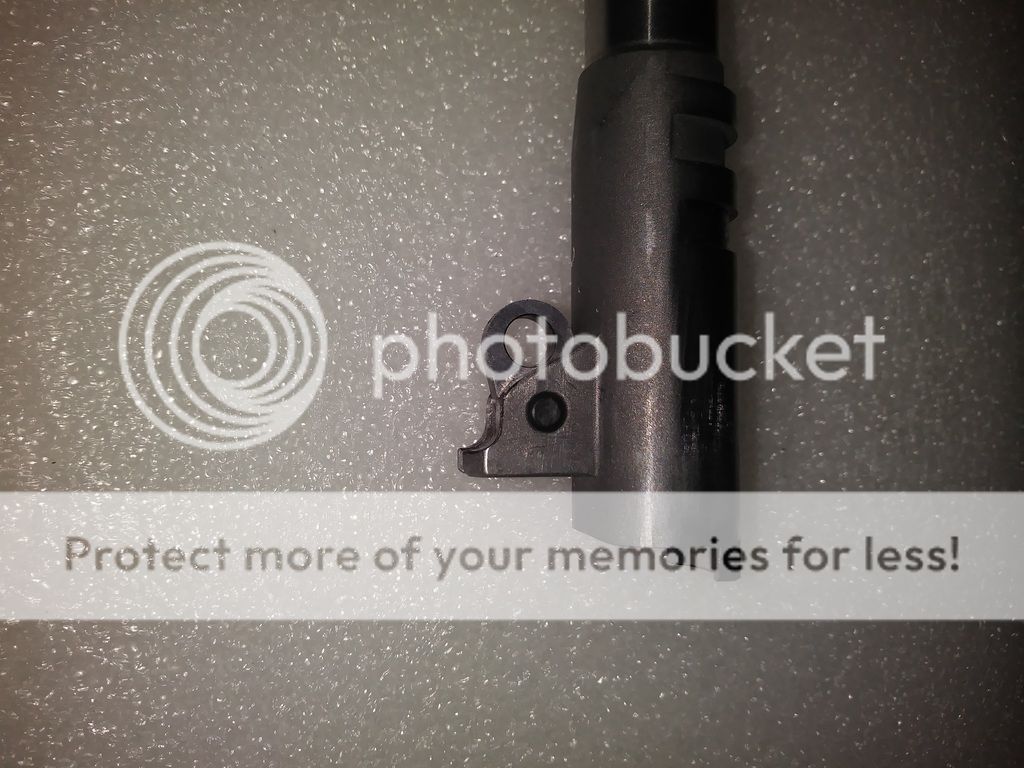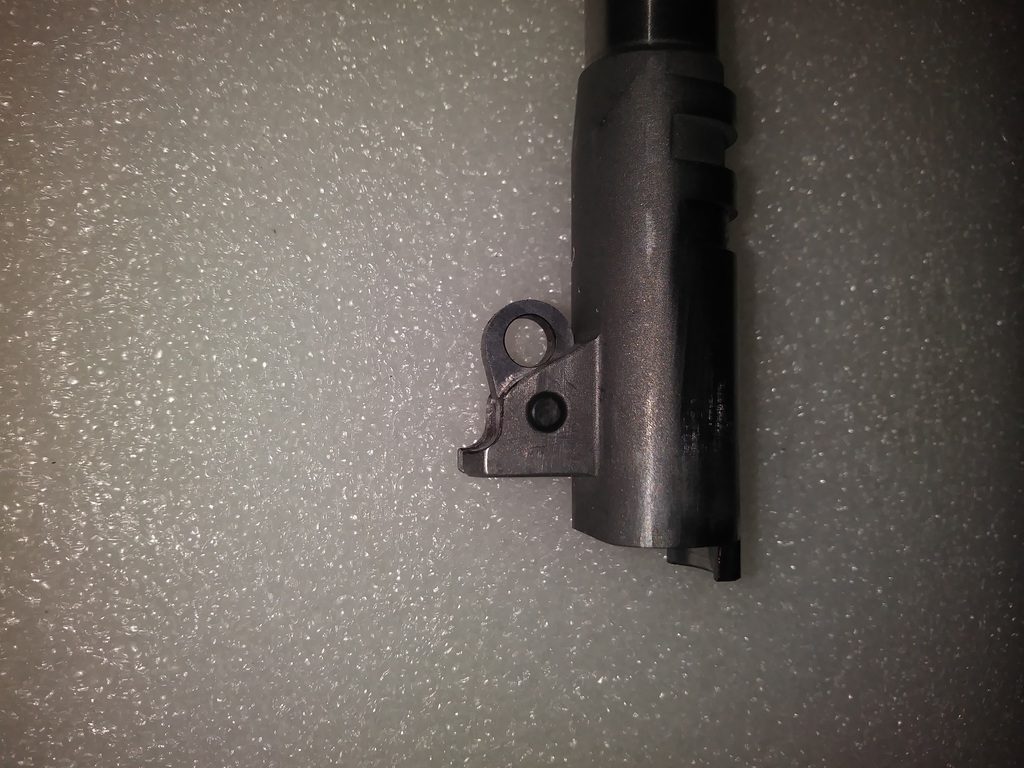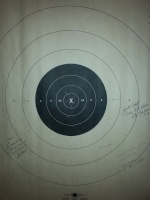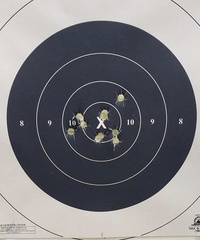Baer Barrel Fit
+21
fpk
Saladman
Rob Kovach
chopper
james r chapman
dronning
Froneck
mikemyers
Warhorse
TomH_pa
Ghillieman
Tim:H11
Toz35m
Wobbley
Magload
zanemoseley
MarkOue
Multiracer
Chris Miceli
jmdavis
Jon Eulette
25 posters
Page 4 of 4
Page 4 of 4 •  1, 2, 3, 4
1, 2, 3, 4
 Baer Barrel Fit
Baer Barrel Fit
First topic message reminder :
[url=[url=https://s280.photobucket.com/user/300redbeard/media/Baer Lower Lugs.jpg.html] [/url]]
[/url]] [/url]
[/url]
[url=[url=https://s280.photobucket.com/user/300redbeard/media/Jon Lower Lugs.jpg.html] [/url]]
[/url]] [/url]
[/url]
[size=48]Here is a picture of a typical Baer (top photo) barrel bottom lug fit. The barrel has approximately 0.010" of bearing surface for lockup. This means the barrel will drop out of battery after slide has traveled 0.010". Translates to higher slide velocity and more felt recoil. The headspace was good on this barrel and sides of hood were sloppy loose. Also the upper barrel lugs were unfit! So QC was on low end of totem pole as usual. The barrel I am fitting has 0.075" of bearing surface for lockup which means slower slide velocity because barrel stays in battery about 7x longer; yes it makes a difference. Proper upper lug fit and hood fit. Baer barrel easily rotates when placed into slide. My barrel will NOT rotate. Hood and upper lug fit prevent it. I've only seen one Baer 45 that the bsrrel was fit correctly in over 20 years. Just because it feels tight in battery doesn't make it right. Just thought I'd share.[/size]
[size=48]Jon[/size]
[url=[url=https://s280.photobucket.com/user/300redbeard/media/Baer Lower Lugs.jpg.html]
 [/url]]
[/url]] [/url]
[/url][url=[url=https://s280.photobucket.com/user/300redbeard/media/Jon Lower Lugs.jpg.html]
 [/url]]
[/url]] [/url]
[/url][size=48]Here is a picture of a typical Baer (top photo) barrel bottom lug fit. The barrel has approximately 0.010" of bearing surface for lockup. This means the barrel will drop out of battery after slide has traveled 0.010". Translates to higher slide velocity and more felt recoil. The headspace was good on this barrel and sides of hood were sloppy loose. Also the upper barrel lugs were unfit! So QC was on low end of totem pole as usual. The barrel I am fitting has 0.075" of bearing surface for lockup which means slower slide velocity because barrel stays in battery about 7x longer; yes it makes a difference. Proper upper lug fit and hood fit. Baer barrel easily rotates when placed into slide. My barrel will NOT rotate. Hood and upper lug fit prevent it. I've only seen one Baer 45 that the bsrrel was fit correctly in over 20 years. Just because it feels tight in battery doesn't make it right. Just thought I'd share.[/size]
[size=48]Jon[/size]
Last edited by Jon Eulette on Fri Aug 18, 2017 2:20 pm; edited 2 times in total

Jon Eulette- Posts : 4399
Join date : 2013-04-15
Location : Southern Kalifornia
 Re: Baer Barrel Fit
Re: Baer Barrel Fit
Here is a super high speed of a 45 being shot on Mythbusters. It shows the bullet exit and the gas discharging from the muzzle before much slide movement...so think there's any blowback going on here?
Delayed blowback, does describe part of what happens. It's a short recoil operated pistol, that starts with a locked breach and ends with slide blowback. Duration and timing of the lock have big impact on accuracy.
The barrel is locked to the slide via the locking lugs, the round is fired and BOTH the slide and barrel moves very slightly backwards until the link "pulls/swings down" the barrel from the slide locking lugs. Then the slide continues rearward on it's own, a delayed separation (unlocking) of the slide/breach from the barrel and you could say that slide/breach blowback happens at this point.
If there was no blowback the slide would not move any further after unlocking from the barrel
- Dave
https://youtu.be/7y9apnbI6GA

Wobbley- Admin
- Posts : 4806
Join date : 2015-02-12
 Re: Baer Barrel Fit
Re: Baer Barrel Fit
If you stop that video at 0:10 and then advance by frame, you will see the slide moving backward ever so slightly before the exit...Here is a super high speed of a 45 being shot on Mythbusters. It shows the bullet exit and the gas discharging from the muzzle before much slide movement...so think there's any blowback going on here?
https://youtu.be/7y9apnbI6GA
Last edited by fpk on Wed Sep 06, 2017 5:56 pm; edited 1 time in total (Reason for editing : said frame when I meant slide!)
 Re: Baer Barrel Fit
Re: Baer Barrel Fit
fpk wrote:If you stop that video at 0:10 and then advance by frame, you will see the slide moving backward ever so slightly before the exit...Here is a super high speed of a 45 being shot on Mythbusters. It shows the bullet exit and the gas discharging from the muzzle before much slide movement...so think there's any blowback going on here?
https://youtu.be/7y9apnbI6GA
In that video the bullet is well out of the barrel by 0:12 and by that time the barrel is just starting to drop away from the slide. Hard to see because everything is blacked out but watch for the barrel drop. It happens as or once the bullet is out. And that's key. So long as the slide moves back thats fine but the barrel needs to stay in "lock-up" until the bullet is out the end of the barrel. Jon's lower lugs keeps the barrel and slide together longer. That's what important for a good feeling and good shooting gun..... If I've understood correctly so far. Correct me if I'm wrong.

Tim:H11- Posts : 2133
Join date : 2015-11-04
Age : 36
Location : Midland, GA
 Re: Baer Barrel Fit
Re: Baer Barrel Fit
We need to remember there is still a lot going on after the bullet has left the barrel........
Jon
Jon

Jon Eulette- Posts : 4399
Join date : 2013-04-15
Location : Southern Kalifornia
 Re: Baer Barrel Fit
Re: Baer Barrel Fit
By time mark 0:20 (5 or 6 frames) all of the gases are out of the muzzle. The slide is just fully unlocked but is getting no assist per se from the residual pressure. The inertia of the slide is all there is. By my calculations the slide at this point has about 82 inch pounds of energy. About 6 inch pounds get absorbed by rather recoil spring and another 7 absorbed by the mainspring, leaves 69 inch pounds in the slide that hammers the frame and ultimately your hand.
Maybe with fit-up this can be slowed down, I don't know. I do know that adding weight like ribs and sights does slow the slide down. It would be nice to have before and after slide velocities. BTW, I never said that that couldn't be done. Just that a 1911 is NOT a blowback, delayed blowback, or retarded blowback ( yes, there is a difference) .
The 191- is and always was a short recoil system with the hammer acting as a retarder.
Maybe with fit-up this can be slowed down, I don't know. I do know that adding weight like ribs and sights does slow the slide down. It would be nice to have before and after slide velocities. BTW, I never said that that couldn't be done. Just that a 1911 is NOT a blowback, delayed blowback, or retarded blowback ( yes, there is a difference) .
The 191- is and always was a short recoil system with the hammer acting as a retarder.

Wobbley- Admin
- Posts : 4806
Join date : 2015-02-12
 Re: Baer Barrel Fit
Re: Baer Barrel Fit
First I requested pressure curve after unlock, what was offered is the pressure curve from ignition to what I'm thinking is the bullet exit point. Any pressure information for blow back discussion would have to be after the unlocking of the barrel. Simple math would show that a bullet traveling at about 870 ft/sec will travel in about 8" in the time frame shown in the graph. However the bullet accelerated to 870 in the time frame shown so if we use a simple doubling of the distance traveled we get a barrel length of 16". The velocity developed by the bullet is in the range of military 45 acp ball. Might be TZZ. Therefore it can be shot in the 1911 ball gun and the curve will be near that of a 1911 shooting the same ammo but somewhat shorter. I'm thinking the exit point of the bullet in a 5" barrel will be near the point that the velocity and pressure cross. Therefore the pressure in the barrel will be a lot higher than shown at about .8msec. Even if 1200psi is used that would equate to about 190 pounds exerted on the slide by the case.
In the myth busters video I don't think they are shooting a 45. First they claim velocity is 1200fps and looking at the bench the magazines seem to be double stack.(thought double stack .45's are available) Then if you were to stop the action as Tim pointed out repeatedly and look at the amount the guide rod is extended out the slide you can see increasing amounts indicating movement of the slide, as you watch the movement look at the muzzle too and see a steady flow of gas releasing at high speed indicating pressure. If not looking at the guide rod area it's very difficult to see the movement but the increasing visible length of the guide rod clearly indicated movement! Area of a .45 case is about 0.16 sq.in. therefore a pressure in the barrel of about 75 psi will be required to over come a 12 pound recoil spring. Also seen is a jet of gas released above the chamber probably indication ignition and stopped as the pressure expands the case forming a seal. Separation of slide and barrel don't happen because of lock-up, some of that pressure is visible as particles exit the barrel at high speed due to the camera frame rate and continue long after the bullet is no longer in the frame and quite a bit of guide rod is exposed. That indicates lock-up has unlocked and that pressure when below a point needed to hold the case in the chamber will push the slide back because at the point of un-lock the barrel no longer can move rearward. Jon is correct, a lot happens after the bullet leaves the barrel.
The thought that the amount of recoil can transfer enough energy to the slide to overcome both the recoil and hammer springs in movement of .050" (the amount Jon stated is the movement needed to un-lock his barrel) would require an extremely fast speed yet when viewing the video the length of guide rod is increasing rather slow given the frame rate is quite fast . That transfer of energy will have to be enough so that the inertia developed will sustain the movement of the slide and over come various springs for about 2"! I was thinking that given the back ground you have that calculation and formulation of kinetic energy would have been supplied.
Gary, I have a friend at the club that sent his LB gun back twice because it would not group 1.5" and that was out of the box! He eventually sent the gun back and got a refund though loosing transfer fees and shipping! He then got a Chambers Gun is quite happy with it! Another issue in not out of the box but what will the gun do after a few matches.
In the myth busters video I don't think they are shooting a 45. First they claim velocity is 1200fps and looking at the bench the magazines seem to be double stack.(thought double stack .45's are available) Then if you were to stop the action as Tim pointed out repeatedly and look at the amount the guide rod is extended out the slide you can see increasing amounts indicating movement of the slide, as you watch the movement look at the muzzle too and see a steady flow of gas releasing at high speed indicating pressure. If not looking at the guide rod area it's very difficult to see the movement but the increasing visible length of the guide rod clearly indicated movement! Area of a .45 case is about 0.16 sq.in. therefore a pressure in the barrel of about 75 psi will be required to over come a 12 pound recoil spring. Also seen is a jet of gas released above the chamber probably indication ignition and stopped as the pressure expands the case forming a seal. Separation of slide and barrel don't happen because of lock-up, some of that pressure is visible as particles exit the barrel at high speed due to the camera frame rate and continue long after the bullet is no longer in the frame and quite a bit of guide rod is exposed. That indicates lock-up has unlocked and that pressure when below a point needed to hold the case in the chamber will push the slide back because at the point of un-lock the barrel no longer can move rearward. Jon is correct, a lot happens after the bullet leaves the barrel.
The thought that the amount of recoil can transfer enough energy to the slide to overcome both the recoil and hammer springs in movement of .050" (the amount Jon stated is the movement needed to un-lock his barrel) would require an extremely fast speed yet when viewing the video the length of guide rod is increasing rather slow given the frame rate is quite fast . That transfer of energy will have to be enough so that the inertia developed will sustain the movement of the slide and over come various springs for about 2"! I was thinking that given the back ground you have that calculation and formulation of kinetic energy would have been supplied.
Gary, I have a friend at the club that sent his LB gun back twice because it would not group 1.5" and that was out of the box! He eventually sent the gun back and got a refund though loosing transfer fees and shipping! He then got a Chambers Gun is quite happy with it! Another issue in not out of the box but what will the gun do after a few matches.
Last edited by Froneck on Fri Sep 08, 2017 4:56 am; edited 2 times in total (Reason for editing : Reply to Gary added)
Froneck- Posts : 1763
Join date : 2014-04-05
Age : 77
 Re: Baer Barrel Fit
Re: Baer Barrel Fit
Doesn't anybody on this thread own a 1.5"@50 yds gun? Then to prove that LB'S 1.5"@50 yds actually shoot 1.5"@50 please post up pics of the test tag & the guarantee that comes with the gun. It's that simple.
Gary Wells- Posts : 370
Join date : 2015-09-07
 Re: Baer Barrel Fit
Re: Baer Barrel Fit
One thing I want to add is how can making the lower lug slide stop contact length longer and therefore unlocking the barrel later in travel slow the speed down so that a lighter spring can be used? Longer contact would allow the recoil more time to transfer energy to the slide and increase the need for a heavier spring. However if blow back was use as a possible explanation then the longer time will allow the pressure in the barrel to lower and have less pressure on the slide and therefore require less spring pressure and explain why when I simply shortened the link length (done as a quick cure before welding the lower lug to improve accuracy) made the gun cycle even with a lighter load.
Looking again at the AMC chart again I see the bullet travel is slightly more than 4" and it attained a velocity of about 870f/sec. Were they using a pistol barrel? I'm also thinking that the velocity and bullet travel distances were calculated to measured other than a chronograph used to get exit velocity of the bullet and a measured time to when the bullet exited the known barrel length. Using that information the plotted information was calculated. I'm sure the best equipment available was used by the Army yet I can't think of any way they could have measured distance and velocity of a bullet inside a barrel especially back in the 70's. Nor can I explain why a pistol length barrel was seemingly used to measure Machine gun barrel data. Could it be that the pressure curve was calculated too?
Another example of this is I just re-bushed a ball gun built by a well known current smith. The lower lug was very similar to the one Jon pictured from LB. I used a Briley Bushing requested by the owner and group tested at just under 2". I later explained to the owner I did not like the lower lug design and use what was told to me by Floyd Aikman. It is very similar to the photo Jon posted of the one he used. My concern was that I didn't know what spring was in the gun but it was the heaviest I've ever seen! I had one hell of a time trying to get it in the typical way by inserting it the end then turning the bushing, I could not! It was almost impossible to keep the lug wrench in position, it was launched a few times too many so I changed to putting it in the bottom with the slide out of the frame. It launched a few times but I eventually got it in. The owner agreed to have me spray weld the lug and change the lower lug shape. Group improved slightly and a 13 pound spring was needed, recoil seemed to lessen also. Still having the gun (Owner wants one of my bronze triggers installed) so I measured un-lock travel distance by measuring the distance the slide travels by pushing the barrel until it stops a total of 7/32" measured with a machinist scale (accurate ruler). So again longer travel lowered spring requirement that is not explained if recoil is used but fits the blow back completion of the cycle theory.
Looking again at the AMC chart again I see the bullet travel is slightly more than 4" and it attained a velocity of about 870f/sec. Were they using a pistol barrel? I'm also thinking that the velocity and bullet travel distances were calculated to measured other than a chronograph used to get exit velocity of the bullet and a measured time to when the bullet exited the known barrel length. Using that information the plotted information was calculated. I'm sure the best equipment available was used by the Army yet I can't think of any way they could have measured distance and velocity of a bullet inside a barrel especially back in the 70's. Nor can I explain why a pistol length barrel was seemingly used to measure Machine gun barrel data. Could it be that the pressure curve was calculated too?
Another example of this is I just re-bushed a ball gun built by a well known current smith. The lower lug was very similar to the one Jon pictured from LB. I used a Briley Bushing requested by the owner and group tested at just under 2". I later explained to the owner I did not like the lower lug design and use what was told to me by Floyd Aikman. It is very similar to the photo Jon posted of the one he used. My concern was that I didn't know what spring was in the gun but it was the heaviest I've ever seen! I had one hell of a time trying to get it in the typical way by inserting it the end then turning the bushing, I could not! It was almost impossible to keep the lug wrench in position, it was launched a few times too many so I changed to putting it in the bottom with the slide out of the frame. It launched a few times but I eventually got it in. The owner agreed to have me spray weld the lug and change the lower lug shape. Group improved slightly and a 13 pound spring was needed, recoil seemed to lessen also. Still having the gun (Owner wants one of my bronze triggers installed) so I measured un-lock travel distance by measuring the distance the slide travels by pushing the barrel until it stops a total of 7/32" measured with a machinist scale (accurate ruler). So again longer travel lowered spring requirement that is not explained if recoil is used but fits the blow back completion of the cycle theory.
Froneck- Posts : 1763
Join date : 2014-04-05
Age : 77
 Re: Baer Barrel Fit
Re: Baer Barrel Fit
Froneck:
The pressure, velocity and travel curves are most likely based on early piezo data taken in the mid- 60s. I dunno, I wasn't there. Don't forget that the arsenals had lots of technical folks with inquisitive minds and because of the Vietnam war a fair amount of money to get data. A few points along a pressure barrel and you can get a best fit.
A 4 inch bullet travel is the true bullet travel in a 5 inch 1911 barrel.
As for reducing the apparent recoil by having the barrel travel longer, you're not dropping the mass of the barrel until it unlocks. The impulse of the round is essentially complete at bullet exit. The extra impulse from the gas discharging is very small.
The impulse for free recoil is normally given as
Mb x Vb + Mp x Vb + Mp x 0.5x Vb; wher Mb Mp are the masses of the bullet and powder respectivel and Vb is the velocity of the bullet. The 0.5 is to add the "jet effect" of the gass exiting the muzzle. Substituting for a typical 45 you get
230x870 + 5 x (870+435). In reality the extra oomph of the powder gas is minuscule after muzzle exit. One even wonders how much extra impulse is even given by the powder charge at all. The 5 grains x435 accounts for about 1% of the total impulse. So the powder impulse is 3 % of the total impulse driving the gun. In an engineering sense this level is noise and can't be relied on to make the whole system work.
The pressure, velocity and travel curves are most likely based on early piezo data taken in the mid- 60s. I dunno, I wasn't there. Don't forget that the arsenals had lots of technical folks with inquisitive minds and because of the Vietnam war a fair amount of money to get data. A few points along a pressure barrel and you can get a best fit.
A 4 inch bullet travel is the true bullet travel in a 5 inch 1911 barrel.
As for reducing the apparent recoil by having the barrel travel longer, you're not dropping the mass of the barrel until it unlocks. The impulse of the round is essentially complete at bullet exit. The extra impulse from the gas discharging is very small.
The impulse for free recoil is normally given as
Mb x Vb + Mp x Vb + Mp x 0.5x Vb; wher Mb Mp are the masses of the bullet and powder respectivel and Vb is the velocity of the bullet. The 0.5 is to add the "jet effect" of the gass exiting the muzzle. Substituting for a typical 45 you get
230x870 + 5 x (870+435). In reality the extra oomph of the powder gas is minuscule after muzzle exit. One even wonders how much extra impulse is even given by the powder charge at all. The 5 grains x435 accounts for about 1% of the total impulse. So the powder impulse is 3 % of the total impulse driving the gun. In an engineering sense this level is noise and can't be relied on to make the whole system work.

Wobbley- Admin
- Posts : 4806
Join date : 2015-02-12
 Re: Baer Barrel Fit
Re: Baer Barrel Fit
Yes I know 4" is the actual barrel length of a 5" 1911 barrel, simply it is the total length minus the chamber with the cartridge in it. Therefor the bullet has only about 4" of rifled barrel ahead of it. However the data given is supposedly for a .45 cal machine gun. Being the velocity is near that of a 230gr Ball 45ACP I guess the curve is similar. Been a loooong time since I was involved with this type of calculation but recoil has to take into account the weight of the gun and since this is the recoil that is activating a moving slide it begins to get quite complicated since the weight of the slide and the barrel are connected to the weight of the frame via the recoil spring. After about .2 of movement the barrel is then separated from the slide and transferred to the frame. Therefore any energy not absorbed in moving the slide is transferred to the frame. Again the results get more complicated in that free movement of the frame will counter and inertia developed in the movement of the slide by the barrel. Being that the 1911 is not mounted but shot free hand I contend that there is not enough energy transfer to the slide to complete the cycle.
To make things simple If adding a comp. will reduce recoil about 50% there must be more than a minuscule amount "jet effect" at the muzzle and looking at the chart that shows about 1400 psi available when the bullet exits the barrel. That equates to about 225 pounds of force being applied to the cartridge case at the time the bullet exits. In addition that pressure will develop enough gas velocity as it exits the barrel and utilized by the comp to reduce recoil by 50% or so it's claimed to be able to. Yet the comp is using only a fraction of the exiting gas and the duration long enough to effect felt recoil. If so then enough pressure to "piston" the case out the chamber and against the slide is within the barrel. This can be seen in the Myth Busters video of the case ejection. Smoke coming of of the case and barrel that the velocity seems quite low but it is not when the frame rate is taken into consideration.
To make things simple If adding a comp. will reduce recoil about 50% there must be more than a minuscule amount "jet effect" at the muzzle and looking at the chart that shows about 1400 psi available when the bullet exits the barrel. That equates to about 225 pounds of force being applied to the cartridge case at the time the bullet exits. In addition that pressure will develop enough gas velocity as it exits the barrel and utilized by the comp to reduce recoil by 50% or so it's claimed to be able to. Yet the comp is using only a fraction of the exiting gas and the duration long enough to effect felt recoil. If so then enough pressure to "piston" the case out the chamber and against the slide is within the barrel. This can be seen in the Myth Busters video of the case ejection. Smoke coming of of the case and barrel that the velocity seems quite low but it is not when the frame rate is taken into consideration.
Froneck- Posts : 1763
Join date : 2014-04-05
Age : 77
Page 4 of 4 •  1, 2, 3, 4
1, 2, 3, 4
 Similar topics
Similar topics» Newer Les Baer 45 Barrel Fit
» Les Baer PII and Les Baer CMP Hardball
» light weight barrel vs bull barrel
» Bushing barrel vs Bull barrel 1911
» Les baer opinions
» Les Baer PII and Les Baer CMP Hardball
» light weight barrel vs bull barrel
» Bushing barrel vs Bull barrel 1911
» Les baer opinions
Page 4 of 4
Permissions in this forum:
You cannot reply to topics in this forum